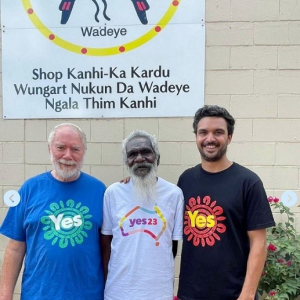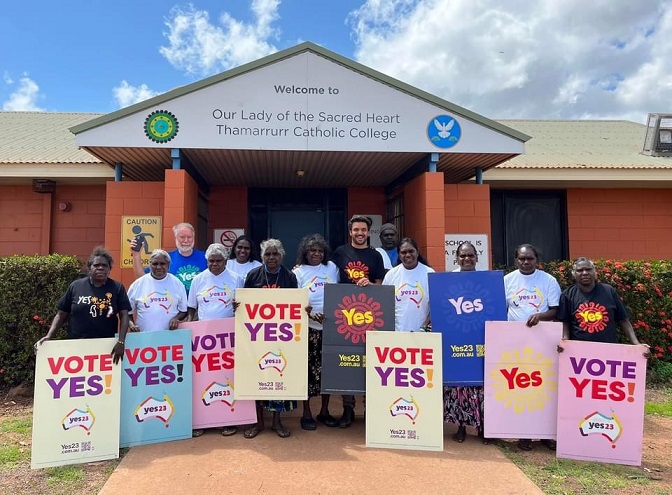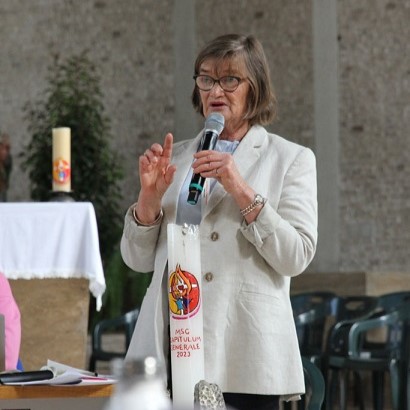Peter MALONE
The Referendum and Voting yes.
The Referendum and Voting yes.
Our 2023 Chapter voted in favour of the Uluru Statement from the Heart.
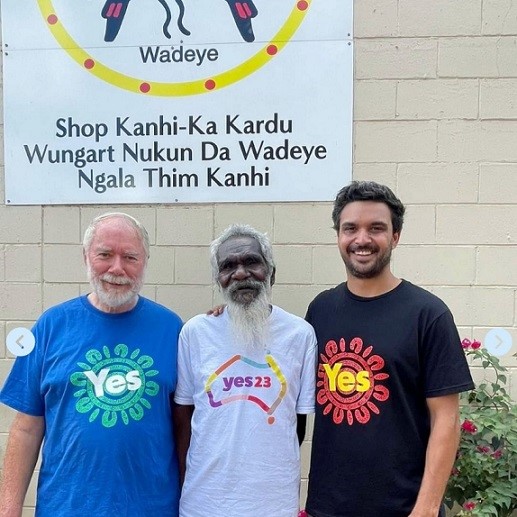
Support for the Yes vote, Leo Wearden and Wadeye
Why I am voting Yes, Pat Walsh (who shared many years of his life with us, at Monivae, many decades supporting Timor Leste righs)
Others will have their own good reasons for deciding to vote Yes or No on 14 October 2023 regarding a Constitutional Indigenous Voice to decision-makers in Canberra. I will be voting Yes, because:
- it is a small way to repay the Indigenous peoples of the Western District of Victoria for the benefits I have enjoyed from their dispossession;
- it is a request that has been made to me by respected Indigenous leaders like Senator Pat Dodson, a former colleague, who has the best interests of his people and Australia at heart;
- it will allow Indigenous leaders to take responsibility and partner with government to rectify over time the deep problems troubling their people;
- it will enhance Australia’s international reputation and make advocacy for victims of human rights in other countries more compelling;
- it is a golden opportunity to further develop our unique story, identity and place in the world and will not materially disadvantage other Australians.

Australian Catholic Bishops Conference Statement on the Voice – May 2023
Australia’s bishops are urging Catholics to engage with the Uluru Statement from the Heart as the country prepares for a crucial vote on the Indigenous Voice to Parliament. The bishops believe that rectifying the omission of acknowledging First Nations Peoples’ custodianship of the land in the Constitution is essential. They encourage all Australians to educate themselves on the proposal and engage in meaningful debate.
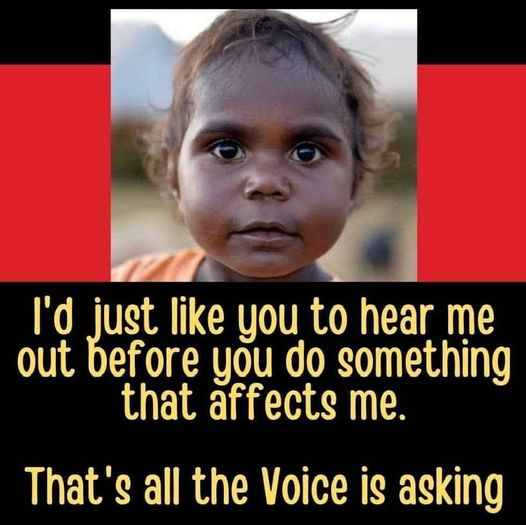
Our Chapter Reports, 5th and 6th Days
Our Chapter Reports, Days 5 and 6

Sylvester Warwakai, PNG Provincial (who spent some time at Cuskelly House, Blackburn, and at YTU)
Fifth Day. 22nd September, by Javier Trapero
This day was dedicated to the memory of the Blessed MSC Martyrs of El Quiché. In the Communal Wisdom Prayer, the text from Psalm 119:97-105 was used for personal reflection and subsequent sharing in the prayer groups. After this time of prayer, Humberto Henriques opened the day’s work and announced, among other things, the birthday of Ms. Doris Maldonado, Deputy in the International Council of the Lay Chevalier Family.

Work was done on the Reports from some of the Commissions established by the General Leadership Team according to the recommendations of the 2021 General Conference, namely:
- Safeguarding Commission: Tim Brenan, as head of the Safeguarding Commission, explained the importance of addressing the issue of safeguarding. Some provincials have had to address this issue in their provinces. Tim wanted to convey to all the capitulants to “not congratulate yourselves for making the document, congratulate yourselves for putting it into practice in your provinces”. Joe, facilitator, proposed a moment of dialogue and personal reflection afterwards with other capitulants.
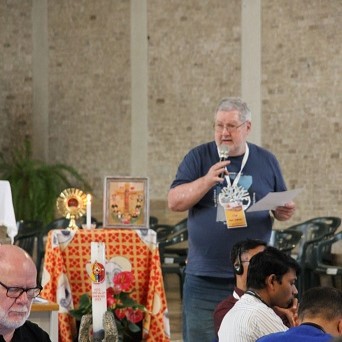
- Commission on International Houses of Formation: Humberto introduced the people who have been working on this issue in recent years, among whom was Bogey Cabrera who died recently. Carl Tranter, one of the members of this commission, intervened to explain the document. The main idea for the dialogue focused on the international aspect of MSC formation.
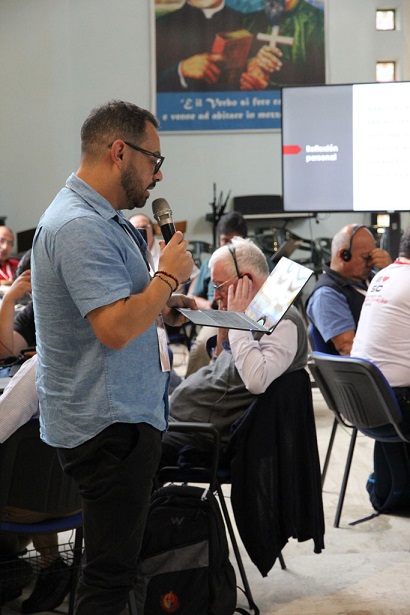
From the two themes of the afternoon, the first session continued the discussion on formation, an issue that was linked to the last session on the older MSC:
- Ongoing formation: Chris Chaplin was in charge of leading this session, which he described as very important and underlined the need for the requirement to have Ongoing Formation coordinators and facilitators at the Entity level.

- Ageing Commission: The dialogue revolved around the Compilation of Congregational Feedback, a document dealing with the issue of ageing and proposals to address it. Joe was the facilitator, but Theo te Wierik and Sam Maranresy, provincials of the Netherlands and Indonesia respectively, showed a reality present in their provinces, stressing the importance of approaching this issue from the perspective of closeness and affection for the MSC who are getting older.
The day ended with the remembrance of the Blessed MSC Martyrs of El Quiché in the Eucharist presided over by Raúl Ruiz, provincial of Central America and Mexico, together with Willy Méndez.
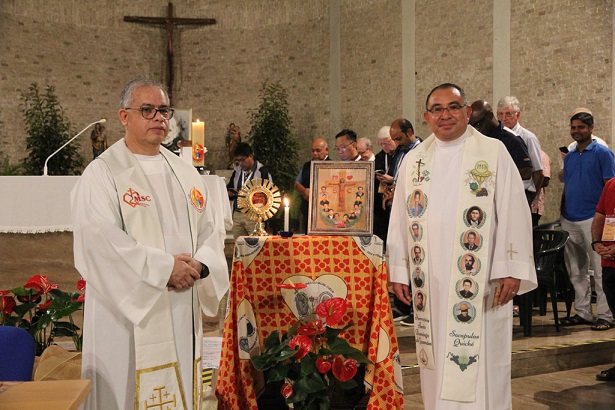
Sixth Day. 23rd September, by Javier Trapero
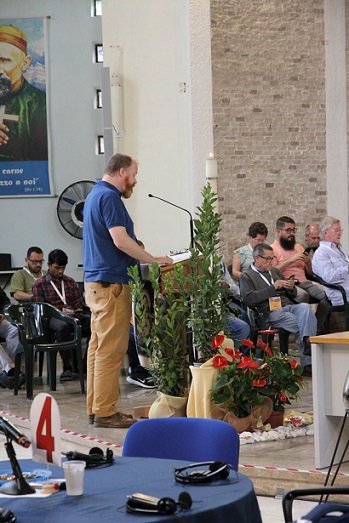
Alan Neville began the Morning Prayer with some texts from Fr. Jules Chevalier and our Constitutions.
“The undertaking may seem foolhardy, but we have signs of God’s blessing […]” (Jules Chevalier, 1866)
“We will do everything for everyone, respecting the different cultures and being ready to take on any apostolic services that people may need […]”. (MSC Const., n. 24) “Elderly or sick confreres who are unable to work continue to participate in the mission of their religious family”. (MSC Const., n. 25)
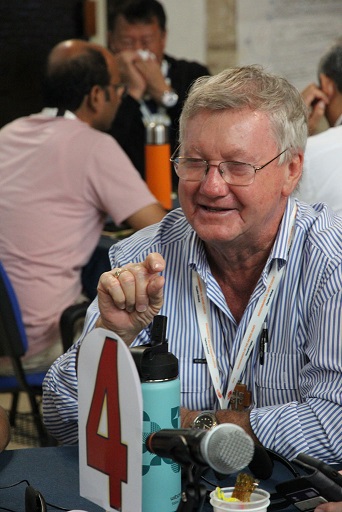
John Mulrooney was the day’s host. He reminded everyone that it was the feast of St. Pius of Pietrelcina, more known as Padre Pio
The day continued with the Commission Reports, namely:
- JPIC Commission
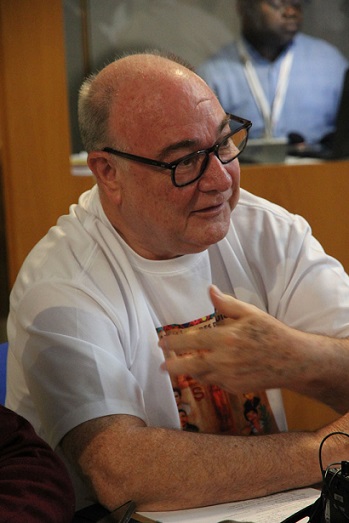
Andre Claessens, JPIC Commission
- Internationality & Mission
- Commission Structures
On JPIC, it was discussed whether it could really become a priority for the congregation in the future and how networking could be created.
Regarding the Internationality & Mission Commission, the discussion focused on interculturality and what mission meant for some MSC in a province that was not their own.
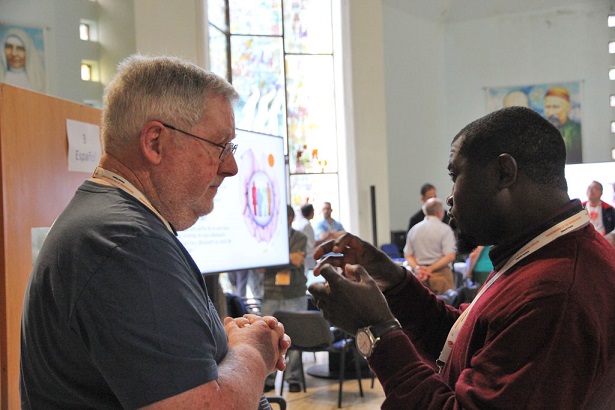
After lunch there was a meeting with Tim Brenan for those capitulants who had questions from the previous day about the Safeguarding Commission. In the said meeting, they were able to present more concrete views on this issue and the MSC General Safeguarding Policy Document that was approved the previous day.
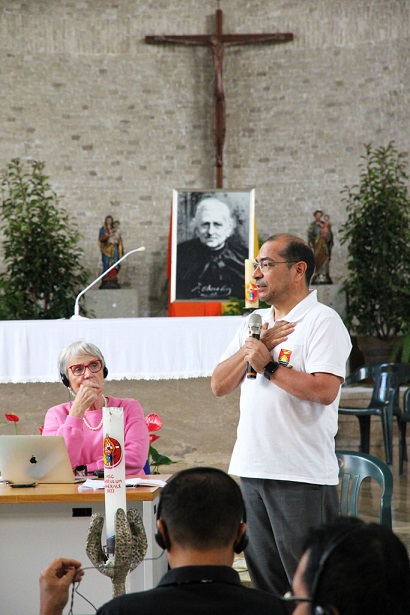
The afternoon was devoted entirely to dialogue on the structures of the congregation for the future. One of the most important topics was the Province of Italy.
The day concluded with a Mass presided over by John Chinnapan, delegate of Indian Union, together with Darwin Thatheus, union superior.
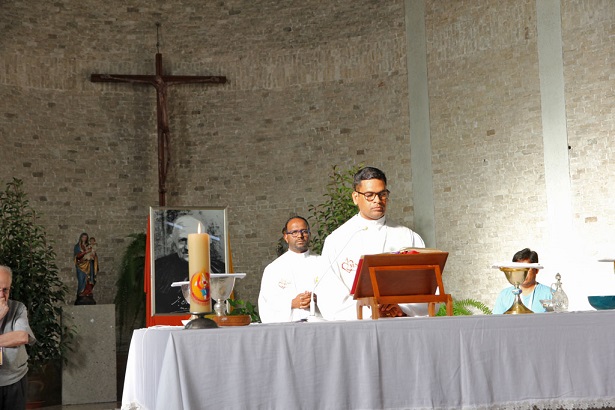
Our Chapter Reports, 2nd, 3rd and 4th Days
Our Chapter Reports, 2nd, 3rd and 4th Days
Alison McKenzie, General Secretary, Laity of the MSC, addresses the Chapter
Second Day. 19th September.
The day began with Communal Wisdom Prayer. Fr. Chris Chaplin, msc, read the Gospel from the on Emmaus (Luke 24:13-27), the same reading that inspired the journey towards this General Chapter. After a moment of silence and personal reflection, the capitulants went to different rooms to share their reflections of prayer with one another.

Peter Carroll
Back in the Chapter Hall and before beginning the work of discernment, Br Joe McKee, one of the facilitators, presented the methodology that will be used on this second day: ‘World Cafe‘. A method of listening and dialogue across language groups to enable the sharing of the concerns and proposals that each senses is emerging from the Chapter for the Congregation.
Each World-Cafe group has large sheets of paper on the table to write, draw or doodle the ideas that arise during the dialogue and that will be put in a ‘parking space’ at the end of the day for delegates to ponder further.
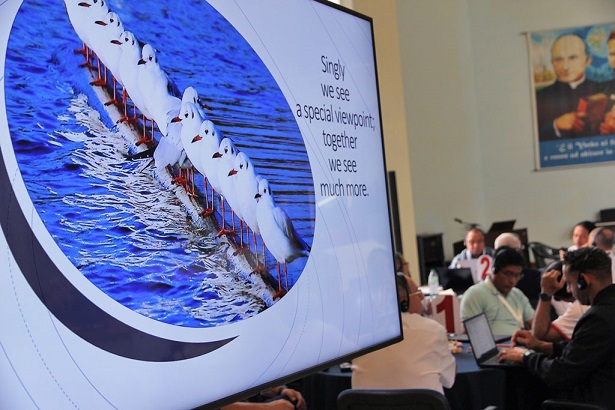
Four questions were posed for this dialogue:
- What strengths do you see?
- Are there areas for growth?
- Do you see any risks or possible difficulties?
- What seems to be emerging that you sense the Chapter needs to consider further?
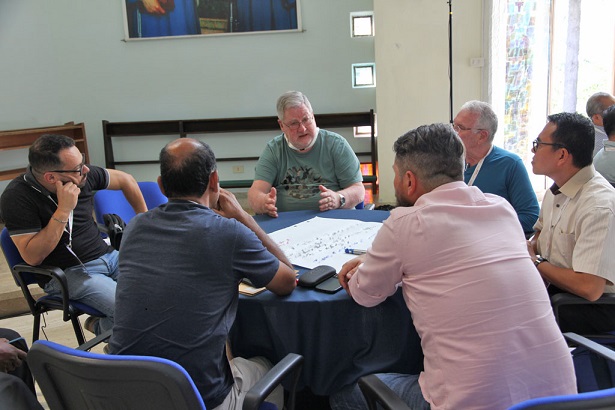
Tim Brennan
The purpose of these questions is to enable the capitulants to have a conversation; sharing the ideas that were collected in the document ‘Compilation of Congregational Feedback’ that was presented at the Online Pre-Chapter Session on June 20-21.
At the end of the day, the reflections of all the working groups, written and drawn on the sheets that were given to them at the beginning of the day, were placed on boards and the walls of the hall, for the Chapter reflection the following day.
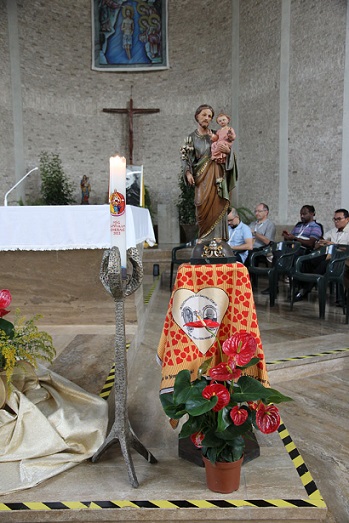
To end this second day of work, Mass was presided by Fr. Juan Tomás García, msc, dedicated to St. Joseph, as the father of Jesus, the heart of God incarnate. An image of St. Joseph occupied an important place in the hall throughout the day.
_____________________________
Third Day. 20th September.
The day began with the daily Communal Wisdom Prayer (Mark 6:30-34), personal reflection, and subsequent sharing in prayer groups.
Ho Tombokan, msc, Indonesian delegate, welcomed the Papua New Guinea capitulars, Fr. Sylvester To Warwakai, Provincial Superior, and the delegates, Fr. Christian Waira and Fr. Fabian Manukailona.
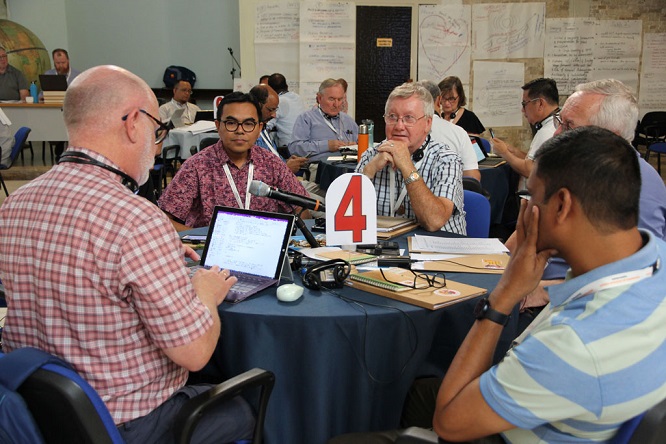
John Mulrooney (and Chris Chaplin)
There were some special moments at the beginning of the day. The whole assembly congratulated Fr. Abzalon on his birthday, Fr. André Claessens on the anniversary of his first profession. and there was a remembrance for the Korean Martyrs, Ss. Andrew Kim Taegon & Companions.
The day’s work began with Frances, facilitator, who explained the main attitude that should be present in the day’s work. Following on from the reading from Emmaus, the main idea of the day was the time for sharing at the table. It was a day of accompaniment as the issues that would be dealt with by the capitulants had to do with the attitude of ‘being present on the road‘.
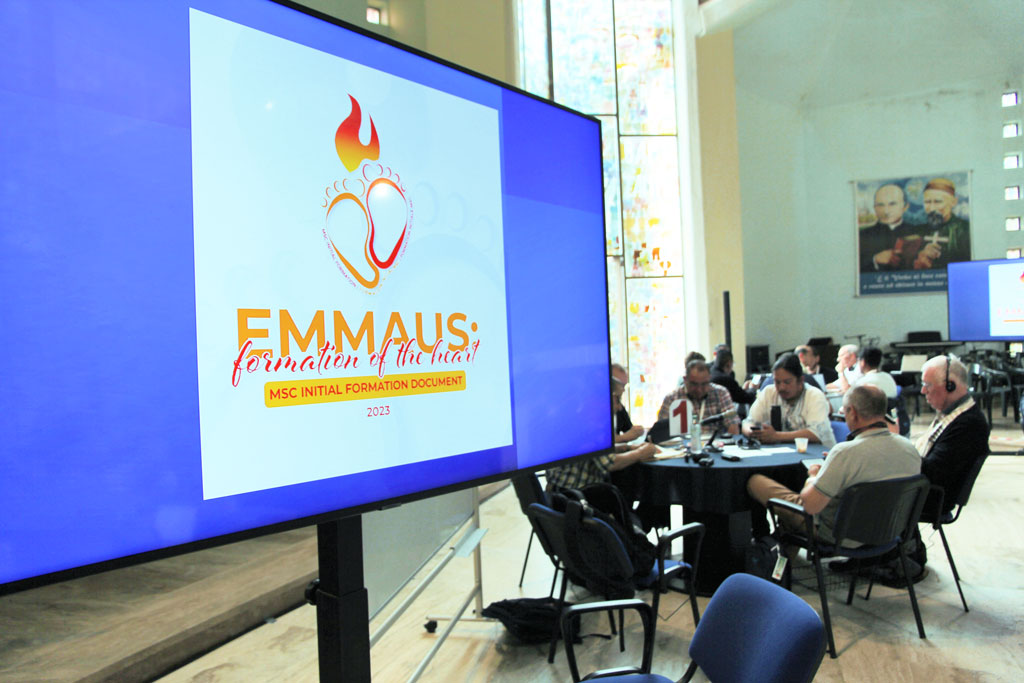
- General Leadership Team vision and accompaniment: The document ‘General Admin Report’ was used.
- MSC Brothers and MSC Identity: Joe, facilitator, introduced the topic with three questions:
- Jesus’ question: “Who do you say that I am?”
- “Who do you say YOU are?”
- “Who do you choose to be?”

Carl Tranter
In the afternoon session, two other themes closely related to accompaniment were also addressed:
- Initial Formation: Fr. Humberto explained the process that started from the first document written on formation 60 years ago, the Valladolid document, to the current one, “Emmaus: Formation of the Heart” with Formation as an idea of accompaniment.
- Safeguarding: The working sessions ended with a theme that the congregation has been dealing with for some time and which will also be important in the future.
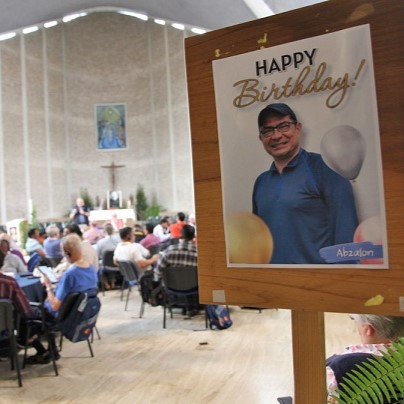
The day ended with the celebration of Fr. Absalon’s birthday, where some capitulants participated in games and songs to liven up the party.
_________________________________
Fourth Day. 21st September.
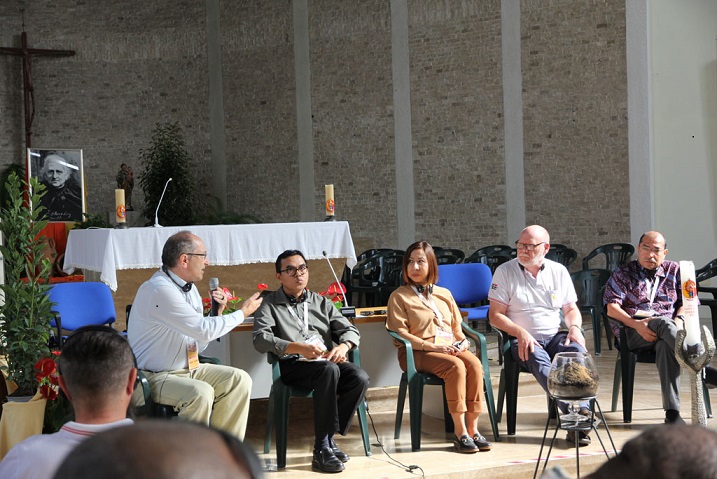
September 21, Feast of Saint Matthew. Both the morning prayer and the evening Eucharist were dedicated to the Evangelist. In the Communal Wisdom Prayer, the reading from James 2:14-26 was read, then each capitulant reflected on the text personally first and then in prayer groups.
Fr. Simone Volavola was the host of the day. He took care of communicating the daily housekeeping: the ordination anniversaries of Fr. Joe McGee and Fr. Herman Van Dijck, as well as the anniversary of their first vows and those of Fr. Carl Tranter, Fr. Michael Curran, and Fr. Ton Zwart.

Michael Curran
The day marked the end of the process of discernment and of work with the documents provided by the General Administration, which were presented and commented on during the Online Pre-Chapter sessions.
- Finance: As in the previous sessions, the morning began with a personal reflection, followed by a presentation in groups. At the end, there was a plenary wherein the capitulants were able to ask direct questions to the people in charge of drafting the document: Fr. Absalon, Fr. Chris Chaplin, Ms. Sofia Amante, Fr. Benny Laisana, and Fr. Michael Huber.
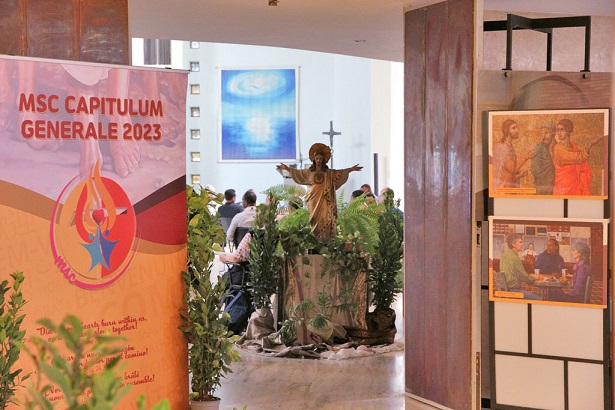
- Laity: The morning ended with a presentation by Frances, facilitator, on the new role of the laity in the Church and the impulse that Pope Francis is giving them. The session was completed by the interventions and testimonies of Ms. Alison McKenzie, Secretary General of the International Council of the Lay Chevalier Family; Mr. Javier Trapero, Responsible for Communications in Spain Province; and Ms. Doris Maldonado, Deputy in the International Council of the Lay Chevalier Family and a lay missionary.
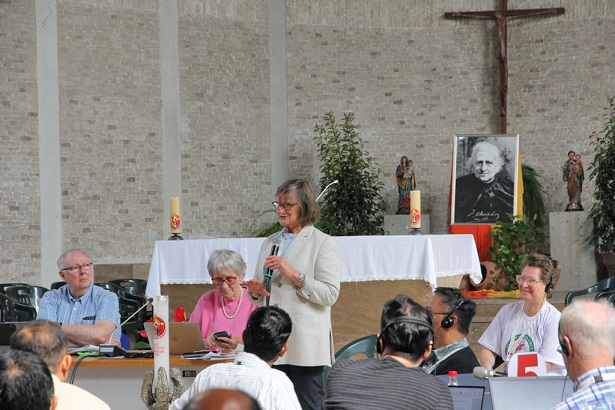
The afternoon’s work dealt with the final topics on the documents of the General Administration:
- Secretariat, Communication, Archives, and Postulation: topics that required less time for dialogue but are of utmost importance for the overall development of the congregation.
Then it was time to conclude the work on the documents provided by the General Administration, and Joe, as facilitator, encouraged the whole assembly of capitulants to have a moment of discernment and to make a synthesis of what had been discussed in these working sessions.

At the end of the day’s work, a Mass was celebrated, presided by Fr. Carl Tranter, in which he reflected on the call of St. Matthew and how his particular vocation and transformation story could resonate with our own discipleship stories.
Daliland
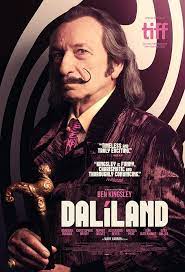
DALILAND
US, 2022, 97 minutes, Colour.
Ben Kingsley, Barbara Sukowa, Ezra Miller, Christopher Briney, Rupert Graves, Andreja Pejic, Alexander Beyer, Mark McKenna, Zachary Nachbar-Seckel, Avital Lvova.
Directed by Mary Harron.
Daliland, the idiosyncratic world of Spanish artist, Salvador Dali. Dali, who died in 1989, and who might well be very pleased with this cinema portrait but not very pleased to realise that, with the passing of time, the 21st-century audience may not know who he is, or was. This is an opportunity to become aware of this most eccentric person, self-centred and arrogant, who achieved a great deal in the world of art, fostering his own publicity.
This film opens tantalisingly with Dali himself on a talk show, immediately recognisable with his upturned moustache, with the contestants blindfold, asking questions – to which Dali says yes to everything. He does look like Dali himself but here is Ben Kingsley, 40 years after his Oscar for playing Gandhi, showing how versatile he can be when embodying unusual characters. It is an excellent Ben Kingsley performance. And he is matched by Barbara Sukowa playing Gala, his wife of many decades, a Russian émigré to France, 10 years older than Dali but with him from 1929 to her death in 1982, demanding on him, protective of him, forcing him to work when he was reluctant, but with an eye to younger men whose careers she promoted.
In checking with sources on Dali and his life and work, a very long entry and detailed in Wikipedia, for instance, for quick research, many aspects of Dali’s character and behaviour described there are incorporated into the film, into Dali’s talk about himself, in the portrait and behaviour of Gala, his hypochondria, food issues, sexuality, voyeurism…
But, this is a dramatised portrait with fictional elements. The principal element is that of the character, Jim, Christopher Briney, an earnest young man from Idaho who begins work in New York for Dali’s agent, attracts Dali’s attention, calling him St Sebastian, but not attracting Gala’s favour. As he goes to work with Dali, meant to keep an eye on him to keep him working for an immediate show, he allows himself to be seduced by this other planet as he calls it, intrigued by the parties, the flamboyant guests, sexual overtones, the New York world of the mid-1970s. We have seen Jim at the beginning of the film, in 1984, watching the Dali show on television, so this is a flashback, his experience of Dali, his genuine love of art but realising he could never be an artist, but then the victim of the whims of Dali, Gala and his agent.
In 1985, he makes a trip to Spain, to visit Dali, caught up in various schemes whereby art paper was bought, Dali signing the pages and then lithographs and prints made of the art and sold as the genuine article (also referenced in Wikipedia). He does his best to help Dali whom he admires but is ousted by Gala.
The screenplay highlights some of the past between Dali and Gala, some flashbacks with Ezra Miller as Dali and Avital Lvova as Gala. But, at the end, Jim visits the artist who is in health decline, to give him a book that he had compiled of the various signatures that Dali used for his work. It emerges that Jim, no longer seduced by this world, runs a small gallery, his love of art.
The screenplay was written by John Walsh and directed by his wife, Mary Harron. In looking at Mary Harron’s filmology, she has brought her audience into some bizarre and exotic worlds, I Shot Andy Warhol, his strange New York world, especially the 1960s; The Notorious Bettie Page, a model who was investigated by the American Senate; and a film version of Bret Easton Ellis’s tale of a predatory young banker, American Psycho. She brings her intrigue with these offbeat worlds, the touches of decadence, to her interpretation of Daliland.
1. Audience knowledge of Dali and his art and career?
2. Salvador Dali as a 20th-century figure, art, celebrity, multicultural?
3. The director, her career, her interests, a New York focus?
4. The focus on Dali in his old age, intimations of the past, the flashbacks of himself and Gala, Spain, Art and career, Luis Bunuel, influence in Hollywood, the visits to the United States?
5. The opening device, the television quiz, the introduction to Dali, his self-confidence?
6. Ben Kingsley’s performance, incarnating Dali? In himself, his character, self-absorption, moods? His relationship with Gala? Issues of sexuality? Art, painting, exhibition, pressures and timetables? His whims? Food, socials, antisocial, his agents, assistants, the media?
7. Or should have Gala, her age, older than Dali, the relationship, over the decades, her temperament, lovers, fostering careers, Jesus and Superstar?
8. Jim, the background in Idaho, seeing Dali on television, moving to New York, his work in assisting Dali, keeping him up to the mark? Interactions with Gala, her dislike of him? His being seduced by this New York lifestyle, the characters, the encounters with Lucy, sexuality, the relationship? Dali calling him St Sebastien?
9. New York society, the parties, lavish, sexuality, the presence of Alice Cooper, the presence of Amanda, Jesus and Jesus Christ Superstar? The presence of Captain Moore, his aide?
10. The impact of the flashbacks, brief, the young Dali, the young Gala, in Spain, the meeting, marrying?
11. Dali later retiring to Spain, his life there, career? Returning to sources?
12. Jim, his visit, tracking down Dali, the reaction of Gala? His book with the variety of signatures? Dali using him on his visit?
13. Jim, the aftermath of his experience of Dali and Daliland, managing his art gallery, his future?
14. Insights into the character of Dali, his career, his style of art?
Eight Mountains, The/ Le Otto Montagne

THE EIGHT MOUNTAINS/ LE OTTO MONTAGNE
Italy, 2022, 147 minutes, Colour.
Luca Marinelli, Alessandro Borghi, Lupo Barbiero, Cristiano Sassella, Filippo Timi, Andrea Palma, Francesco Palombelli, Elisabetta Mazullo.
Directed by Felix van Groningen, Charlotte Vandermeersch.
This is a drama about friendship. It is also a drama about the different paths that life takes.
While the setting is the Italian Alps, filmed spectacularly in the mountains, the valleys, the lakes, in the variety of seasons, the beauty and tranquility of summer, the snow and the dangers of winter, the title does not just simply refer to these locations. Rather, there is a drawing, echoes of Eastern mysticism, a circle, lines of division across the circle forming different sectors, but a central point, a peak. The explanation is that one can go to the centre, the peak, remain there or, rather, one can travel about the different sectors, the eight mountains.
Which is the template, so to speak, for the two characters in this film. They are Pietro and Bruno.
The two meet as boys, 11 years old, Pietro coming from Turin with his parents for the summer holidays in the Alps, Bruno a boy at home in the mountains. They share a number of adventures during the holidays, become good friends, share climbing with Pietro is demanding father, Bruno showing grit, Pietro weaker. And then Bruno suddenly leaves, his father leaving the mountains and going to work in the city as a bricklayer. This childhood section of the film is very engaging.
The narration of the film is by Pietro and he reveals to us that several years pass and the two teenagers paths cross, Pietro recognising Bruno coming into a bar, Bruno nodding but then leaving with his fellow workers. And then, with some dismay, Pietro reveals that they did not see each other for 15 years. In the meantime, Pietro has clashed severely with his father, his father demanding on his son, the son walking out, not really making anything of his life, odd jobs, cooking, keeping in touch with his mother.
It is Bruno who makes the move after the 15 years, listening to Pietro, then revealing the Bruno has been in touch with Pietro’s father over the years and had received a bequest from him, asking him to build a house high in the mountains. The invitation is for Pietro to work with him.
This gives Bruno a sense of direction, handling his bricklaying skills, reminding him of his love for the mountains, is deciding to stay, cattle, milking, cheesemaking, eventually marrying one of Pietro’s friends, a daughter, prosperity, financial difficulties…
While Pietro values connecting with Bruno and also the achievement of building the house, his life in Turin seems to have little value, Bruno reminding him that once he thought to be a writer. This does have an effect on Pietro who travels, visits Nepal, beautiful vistas of other mountains, is meeting the people, feeling at home, a deeper sense of himself and his abilities, writing and publishing.
And so it goes over the years, Pietro in Nepal establishing a life there, returning to Italy and bonding with Bruno and his family, with his mother.
This is a film of a long time friendship, bonding, sharing, absences, encouragement, achievement, failures, sadness. Bruno has stayed at the centre in his mountain while Pietro has travelled and experience the wider range of the eight mountains.
- An Italian novel and writer? Belgian writers and directors?
- The title, the drawing, the central mountain, the surrounding mountains? The central fixed mountain symbolising Bruno, the other mountains of space symbolising Pietro?
- The beauty of the scenery, the Alps, the mountains, the different seasons, the paths, the lakes, the homes, building the house, the farm? The comparison with the Himalayan scenery, the mountains, seasons, the towns, homes, shops, schools? The musical score?
- The early part of the film, the boys, aged 11, Pietro, from Turin, a city boy, education, relationship with his father, a demanding father? The support of mother? The encounter with Bruno, a boy from the mountains, his father moving to the city from farming, bricklaying? The friendship between the two boys, the scenes of them in the mountains, playing together, depending on each other, Bruno the leader? The scene of the boys with Pietro’s father, the altitude, the crevasse, Bruno leaping, Pietro unable to, his father’s reaction? His father always urging him on? The summers, the separations? Bruno and his disappearance, to work with his father? Pietro’s response?
- Then several years later, Pietro, in the bar, seeing Bruno with the workers, the nod, and not seeing each other for 15 years?
- Pietro, the confrontations with his father, not wanting to be like him? Leaving? The jobs, the bar, cooking? Not really settling? His father’s death? The support of his mother?
- Bruno, 15 years later, the encounter between the two, Bruno’s life, bricklaying and work? always seeing himself as a man of the mountains?
- The bonding between the two, the sharing of their stories of the years? Bruno, the invitation to build the house, the site, the bequest from Pietro’s father, Pietro discovering the bond between Bruno and his father, their travels – and later going to the different mountains, recovering the books, reading the mementos of his father?
- The building, the work, the stone, the timber, bring it up the mountain? Pietro and his climbing the mountain, standing at the peak and calling to Bruno? Pietro bringing his friends from Turin, their response, ecology consciousness? The relationship with Lara?
- The years passing, the visits to the mountain, Bruno staying, the cows, the milking, making the cheese, fulfilling his ambitions?
- Pietro, travelling, the past urge to write, lacking self-confidence, going to Nepal, the experience, the different mountains, the people, bonding with them, the details of his life there? His writing, eventually publishing?
- Bruno, the relationship with the Lara, her business sense, her pregnancy, the birth of their daughter? The years passing? Pietro and his returning? The financial difficulties, Lara and the clash with Bruno, his stubbornness, her taking the daughter, going down from the mountain?
- Bruno, his decision to stay, to manage, the man of the mountain, the fixed centre? Pietro and his regular visits, the discussions, the confrontation, Pietro unable to help Bruno, Bruno ousting him? Pietro deciding to return, finding Bruno again, the skiing?
- Pietro, Bruno’s disappearance, the helicopter, the search, his absence, waiting for spring, the melting snow, the crows picking up the body? Bruno and his achievement in his ambitions – but also the cost?
- Pietro, finding fulfilment’s life, returning to her the teacher in Nepal, with the children, playing ball, his future?
- A portrait of male friendship over many decades? Joys, sorrows, regrets?
Equalizer 3, The
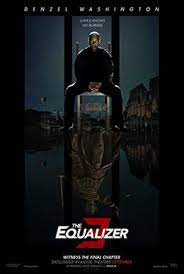
THE EQUALIZER 3
US, 2023, 109 minutes, Colour.
Denzel Washington, Dakota Fanning, Eugenio Mastandreo, David Denman, Gaia Scodellaro, Remo Girone, Andrea Scarduzio, Andrea Dodero.
Directed by Antoine Fuqua.
Denzel Washington has shown quite some versatility in his range of characters over a career of more than 40 years. In his 50s, while still making serious films (Fences, Macbeth), he set out on the action hero path (many commentators noting the parallel with the career of Liam Neeson who is two years older than Washington). And, with the 2013 action show, Denzel Washington became The Equaliser. The second episode in 2018.
One of the criticisms of this kind of franchise is that it becomes formulaic. Critics often dismiss the formulaic – but audiences are expecting the formula, to see the variations, to test how they work. Which is very much the case here.
However, this film has the great advantage of being set in Italy and offering some spectacular local scenery. The southern Italian town where the action is set (although there are some excursions to Naples and Rome) consists of sunny white buildings perched on an extraordinarily high crag, from the sea to a mountaintop. And, life in this town is what we might expect from Italian films, a genial population, a most sympathetic Dr, a nice parish priest, the police, shopkeepers. But…
We are in southern Italy, visits to Naples, and, as to be expected, the Camorra, smug and arrogant thugs, conscienceless, wanting to turn the picturesque town into a tourist and casino-gambling destination, using intimidating and violent tactics to overcome any opposition.
However, Robert McCall, the equaliser is there. A prologue introduces him, confronting drug dealers in Sicily, overcoming any opposition with technically expert violence, taking their money cache. But, it would seem the film is almost over at the beginning when he is shot in the back, unexpectedly by a young boy, contemplates dying, but gets the ferry and is picked up by the local police, treated by a sympathetic Dr, recovering, finding the town congenial, an obvious place for a happy retirement. But… The Camorra.
There is quite some complication given Robert McCall’s background and his role as a hitman involved in international detection. He chooses a young CIA agent, played by Dakota Fanning (who, as a child, starred with Washington in 2004 in Man of Fire). He gives her information, she getting to work with her collaborators, coming to meet him in the town, following his leads, which, in fact, almost get her killed.
Interestingly, McCall does not go in for big a spectacular shootout’s. Rather, he is a quiet individual, a talent with literally gripping opponents, picking the thugs of one by one, making a dramatic climax for the action.
Which means that this time Robert McCall, with Denzel Washington is intensity but also his genial smile and kindness in the town, make The Equaliser something of a genial psychopath in his behaviour. Is this the end of the franchise? Or will Dir Antoine Fuqua and Washington come up with another episode because this one has proven the most popular at the box office?
- The popularity of the first two films? Denzel Washington, action hero?
- The background of Robert McCall, the first two films, personal suffering, active involvement, hitman, the CIA connections, his skill in espionage, action, killing – genial but with the touch of the psychopath?
- The prologue, Sicily, the drugs issue, the farm, the men, the shootout, Robert being held, turning the tables, the shooting, finding the money, taking it, the scene with the boy in the truck, the boy shooting him, the wound, contemplating suicide, in the car, the ferry, collapsing on the highway, the policeman finding him, the rescue, the doctor healing him, going to the town?
- The visual beauty of the locations, the town on the steep cliff, old buildings, white buildings, the streets, homes, stores, the church? The musical score?
- Robert, bonding with the doctor, calling every wound simply a fall? The gradual recovery, the question of whether he was a good man or a bad man? Moving around the town, the cafe, cups of tea, finding the town congenial, limping, the stairs, the priest, gradual recovery?
- The background of the Camorra, Vincent, the boss, the meetings in Rome, his ambitions, transforming the town, casinos and tourists? His henchmen, the discussions? His brother, wild, brutal with his friends, the bikes? The brother coming to the town, the threat to the shopkeeper, demanding the money, the bashing? Robert observing? The confrontation in the piazza, the priest, the police and the bashing?
- The brother and his gang returning, in the restaurant, the confrontation with the policeman, taking his daughter, the threats to his wife, the bashing? In the restaurant, the confrontation with Robert, the equalizer and his skills, touching the nerve, ousting the brother? Retreating?
- The return, the threats, Robert and his dealing with the whole group, the gruesome deaths? Vincent and his response?
- The religious procession countering the killings?
- The life of the town, the doctor and his reputation, the policeman, at the shops, the children? An attractive picture of southern Italian life?
- The contrast with scenes in Naples, Vincent and his home? The scenes in Rome, the terrorist attack on the station? The CIA officers?
- Robert and his phone call to Emma, giving her the information, her acting on it, the CIA, the Sicilian situation, drugs, terrorism? Working with her associate, Frank Conroy?
- Emma coming to the town, Robert recognising her voice, the conversations, his picking her for success, giving her the information, her research on him? In Rome, the threats to her, Vincent and his crew despising her, going to her car, Robert’s phone call, the explosion, her being saved, hospital? The issue of the money, Robert visiting her, the return of the money, the beneficiary, Emma and her visit to Boston and handing over the money? Generosity of an equalizer?
- Vincent and his thugs, arrogant, smug, playing cards, in his mansion? Robert, the infiltration, the action sequences, overcoming everyone, the confrontation with Vincent, the wounds, Vincent fleeing outside the house, in the street, hit by the car?
- Robert, returning to the town, happy to be there, equalising for them, a happy retirement? Or?
Theater Camp

THEATER CAMP
US, 2023, 92 minutes, Colour.
Ben Platt, Molly Gordon, Noah Galvin, Jimmy Tatro, Caroline Aaron, Ayo Edebiri, Amy Sedaris, Kyndra Sanches, Alan Kim.
Directed by Molly Gordon, Nathan Lieberman.
It will very much depend on your sense of humour if you enjoy this story of a summer camp for youngsters interested in performance. And it may also depend on the national sense of humour. Most of the comments coming from the United States find the film hilarious. Though not all. For non-Americans, it might be amusing in many ways, but hilarious?
As the title suggests, this is one of those stories of an American summer, a summer camp where aspiring youngsters go to an upstate New York site in the Adirondaks (AdirondACTS) to develop their talents, acting, singing, mime, technical know-how for putting on a show, the theme very popular in American films over the decades. And, it can be noted from the title that there is also an emphasis on the other meaning of camp.
Audiences who have enjoyed the different versions of Fame, who enjoy television’s Glee, will probably be keen to see this film. And they will enjoy the theatrical references, the quotes from the musicals – and many favourable commentators noting that the film is for “theatre nerds”.
The actual camp struggles to survive, the founder campaigning to raise funds, then suffering a stroke from the strobe lights of a performance of camp Bye, Bye Birdie, in coma. Her rather boofhead son has to take over the running of the camp, tone deaf to most things, fancying himself as an entrepreneur (his name is Troy so he is an entroypreneur), being tempted to sell out to the upmarket similar camp adjacent.
The film actually spends more time bringing the staff characters to life, a couple of who have taught singing and put on the annual musical for 13 years, Ben Platt and Molly Gordon. There is also the tech man who, at a pinch, can improvise quite a dance sequence and, surprisingly, is very effective at female impersonation for the crisis in the annual show, Noah Galvin. There are various other assorted members of staff, teachers, costume design, and a fake intruder.
Much less attention is given to the characterisation of the students, seeing them perform, many with quite some talent, but Are Not really getting to know most of them – except a rather haughty and ambitious performer and a youngster training to be the pushiest and persistent of talent agents.
So, lots of theatre references for those in the know, quite a number of farcical situations and conflicts, a climax, of course, with the final show, amusing in its way.
Nun II, The
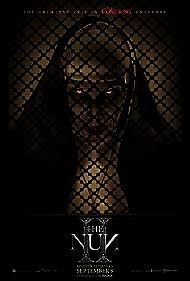
THE NUN II
US, 2023, 110 minutes, Colour.
Taissa Farmiga, Jonas Blocquet, Storm Reid, Anna Popplewell, Bonnie Aarons, Katelyn Rose Downey.
Directed by Michael Chaves.
It is five years since the appearance of The Nun, part of the very successful horror franchise, The Conjuring, based on the real-life activities of exorcist couple, Ed and Lorraine Warren (Patrick Wilson and Vera Farmiga who appear again in the final credits – and star,Taissa Farmiga, is Vera’s younger sister). Most of the comments on this sequel note that it is better than the original. The narrative here continues with the storyline as Well Is key characters from the original.
In fact, much of the narrative of The Nun II is very similar to that of the original (and this reviewer, noting the original review, found that much of it could be re-said here.)
Sister Irene, Taissa Farmiga, was commissioned in the first film to be an assistant exorcist with the priest, both sent by the Vatican to Romania, encountering diabolical presences, especially in the form of a sinister and frightening -looking nun. In Romania was a sympathetic gardener, Frenchy, who is also possessed by the Demon. That was set in 1952.
This film opens in 1956, and was filmed at an abandoned church in France, the setting here. Once again, the nun has appeared and a priest literally goes up in flames. In the meantime, there is a girls’ school nearby, a nice student with her mother a teacher, bullied by the girls, a severe headmistress. But there is a sympathetic gardener, Maurice – who, in fact, is Frenchy, come from Romania (with Belgian actor Jonas Blocket reprising his role), charming everyone.
Back home, Sister Irene listens to rather ghostly tales told with relish by some of the older nuns. She has a friend, Sister Debra, Storm Reid, whose parents have fled the American South with Debra finding herself placed in the convent. She has a sceptical attitude and would love to see a miracle. When a bishop sends sister Irene to France, reluctantly because she was so scarred by the experience in Romania, Debra accompanies her.
While there have been some scares and frights early in the film, the middle part is the Sisters travelling, assessing the situation, seeing what happens in the school.
However, for the last 30 minutes and more of the film, there is no lack of scares, frights, sinister behaviour, diabolical apparitions – and a reminder that Sister Irene feels she was responsible after Frenchy/Maurice had saved her in Romania, that the Demon had entered him (shown in flashbacks). So, he is re-possessed, pursuing the nuns, pursuing the young girl and her mother, terrorising the other students. There is also a monstrous goat. This is very much a female-oriented film, Maurice being the only significant male character. And Debra, who has also been terrorised, declares that she has seen some miracles.
As with the previous film, this is an imagination based on folkloric aspects of Catholicism rather than theology and ritual. Sister Irene, especially not in the 1950s, would not have been an immediate choice to go out on exorcisms. And her rituals, such as they are, are very basic, although she and Debra do say the words of consecration and barrels of wine come gushing out destructively – and they have mentioned that a relic used in previous exorcisms was a phial with the blood of Christ. This time, however, there are references to St Lucy, her being blinded, and, her eyes kept in a reliquary which certainly achieves exorcism success.
If an audience enjoys this kind of religious horror-exorcism film, there is plenty here.
- The popularity of The Conjuring franchise, the background of exorcisms, the Warrens, based on real-life? And the further developments and imaginations? The original, The Nun?
- The favourable commentary on the sequel? But the repetition of the major aspects of the plot? Of the Catholic folklore rather than theology?
- The tradition of exorcism films, Catholic films, priests and exorcists, non-Catholic exorcism films, secular exorcism is, in other religions?
- The continuity, Sister Irene and her role in exorcism in the first film, Romania, the encounter with Frenchy, with the priest, the Vatican commission? The effect of the exorcism on her? Four years later, in the convent, the community, the older nuns, telling horror stories in community, Debra, young, difficulties in the American South, her family moving, placing her in the convent, her smoking, scepticism, wanting a miracle, support from Irene?
- France, 1956, four years after Romania? The opening, the priest, the boy in the sacristy, the issue of the wine, the ominous presence in the cellar, the appearance of the nun, the boy and his horror, the priest and going up in flames? The church not being used afterwards? But the boy in the town?
- The girls’ school, Sophie, her mother, the bullying girls and their laughing, tormenting Sophie, locking her in the room? The experience of the image of the goat, the red light in its eye, her terror? Her mother, teaching in the school?
- Frenchy, charming, the gardener, his bond with Sophie, Captain? His demands on the other girls? The bond with Sophie’s mother?
- Irene, the visit of the carnival, the commission for her to go to France? Talking with Debra, Debra going with her, the travels? The arrival in the town, the problem of accommodation?
- Irene, as exorcist, the experiences in the town, her talking with the young boy? Sophie, her mother? The support of Debra? The church, the sacristy? The belltower?
- The encounter with Frenchy, the flashbacks to the past, his rescuing her in Romania, the serpent entering him, his being possessed? His bringing the demonic presence and the nun to France?
- The episode with the headmistress, the story of her son, her severity, the mischievous girls putting the moths, wanting Maurice to remedy the room, the violence of her death? Her later menacing appearance?
- The folklore for exorcism, a woman exorcist, the young nun, her prayers, the issue of the phial of the blood of Christ, the red eye of the goat and the torch and Sophie rescuing it, the dangers as the possessed Frenchy attacking her? The image of St Lucy, martyr, blind, patron of the blind, the symbolism of the reliquary with her eyes? The importance of these for the exorcism? Minimal prayer and blessings, Debra and Irene quoting words of consecration, the wind, image of the blood of Christ, its deluge effect?
- The last half hour, scares, frights, horror, the girls being menaced, Sophie in the belltower and the fall, her mother and concern, Debra and the attack? The image of the goat, the monstrous goat, the chases, the corridors, the locked doors? The nun, the images on the walls, the reality, towering, menace?
- Irene, the successful confrontation, Irene being set alight, Debra recovering her? The attack on Maurice, the exorcism, exhaling the demon, his recovery?
- The impact on Irene, Debra and her saying she had witnessed a miracle after her early scepticism? The future at the school, Maurice, Sophie and her mother?
Everybody Loves Jeanne/ Tout le Monde Aime Jeanne
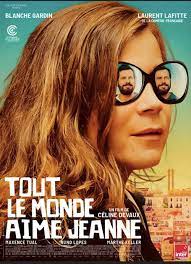
EVERYBODY LOVES JEANNE/ TOUT LE MONDE AIME JEANNE
France, 2022, 95 minutes, Colour.
Blanch Gardin, Laurent Lafitte, Maxence Tual, Nuno Lopes, Marthe Keller.
Directed by Celine Devaux.
Except herself…
The main characters in this lightly serious study of characters who are in their 40s, 20 years of experience of adult life, joys, disappointments, achievements, failure.
We are introduced to Jeanne, an ambiguously sympathetic performance from Blanche Gardin, a high achiever with a scientific project for capturing plastic in the ocean, some details of the machine and how it might work. But, then disaster, the machine collapsing into the ocean, Jeanne desperately diving in to save it, captured on photo and video, continually reproduced indicating her desperation in the failure.
Which means then that Jeanne is fairly morose throughout the film, touching on depression, walking lonely, in sombre black, avoiding relationships. And then there is the revelation as she meets her sympathetic brother, Simon, to discuss her financial situation, near bankruptcy. Their mother had left them a note, had committed suicide, a cold mother. And, it would seem, the only way to survive financially is to sell the apartment in Lisbon where she lived and they had grown up.
In case this sounds too sombre, it is important to mention the very important device that the writer-director, Celine Devaux with her first feature film, relies on throughout the narrative. She and her associates have drawn animation interludes. In fact, these interludes are from Jeanne’s interior life and voice, often contradicting her exterior and her behaviour, humorously drawn and with Jeanne’s interior voice). There is an animated character for Jeanne, black-and-white, long hair like a life-sized mop, but almost anonymous in look, but with a great deal to say, voicing the real Jeanne. And, at times, there is ground animation in different designs to arrest our attention.
This animation certainly makes the film different, gives it a life and vitality, but also gives it a truer psychological perspective, a truer moral perspective.
Off Jeanne goes to Lisbon sell the apartment, encountering a bright and breezy Jean (Laurent Lafitte) at the airport, students at school in the past, her not remembering. Needless to say, he is more than persistent, making contact in Lisbon, visiting the apartment, pretending to be her husband for a prospective buyer, outings with his niece and Jeanne to the beach – and a very strong scene, with some pathos, where he discusses his mental health, committed to an institution for some months, the aftermath.
Also in the picture is Vitor, with whom Jeanne had a relationship in the past. Again a bright and breezy character, choir teacher, with Jeanne’s niece in his class – and their all going to enjoy a school concert.
There are a lot of quirky episodes with little explanation, miniatures, so to speak, illustrating characters – Jean and his niece suddenly stealing a motor bike and riding off, Jeanne with Simon and his son packing up and going on a spree of smashing plates…
So, a lot of people do love Jeanne in their way, that interior Jeanne sometimes responding, but will she overcome her despondency and believe this?
Burning Hearts/ Ti Mangio il Cuore
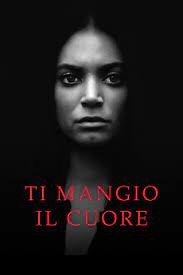
BURNING HEARTS/TI MANGIO IL CUORE
Italy, 2022, 115 minutes, Colour,
Elodie, Francesco Patane, Lidia Vitale, Francesco Di Leva.
Directed by Pippo Mezzapeso.
This is a striking drama. It also is a very grim story from southern Italy, traditional families, working the land, farms, yet deep-seated rivalries, rage, vengeance and violence. The Italian title suggests that a vengeful heart will gnaw at us.
And, again very strikingly, it is filmed in black and white.
The opening sequence sets the tone of the film, massacres on a farm, one family destroying the other, shooting, a little boy surviving hiding in the shed, and the huge herd of pigs emerging with him, and a close-up on his face, the face of vengeance. It is 1960.
The action then moves to 2003, the little boy is now the Don Michele, married, grown-up sons, working the farm, but still in rivalry in competition with the opposing family. There is also a third family in the region who seem to act as a buffer between the two rivals – but, as we finally see, that is the surface appearance.
The screenplay suggests to us that we think about the Montagues and the Capulets, but not quite in the Romeo and Juliet romantic perspective. They were from northern Italy but their lives were lives of vengeance in rivalry. Now, there is a tense relationship, sexual, between one of Don Michele’s sons, Andrea, and Marilena (popular Italian model and singer, Elodie), the wife of a son of the other family who has had to disappear, hiding in a cave. They have two children.
There are tensions when lovers meet, Don Michele observing, commanding his son to break the relationship – and his son swears he will but immediately meets Marilena again (and quite a delightful small sequence as he charms her children).
We know that where this will lead – and it does. Except that there is the surprise killing of Don Michele but vengeance tells his family that all the generation of their opponents must be eliminated in compensation. And, with varying degrees of grimness, this happens.
But the film moves in developments we might not have anticipated. Marilena seeks refuge with Andrea’s family, which they accept, reluctantly, especially severe is Andrea’s mother, and outspokenly vengeful matriarch. Complications, pregnancy and Marilena becomes part of the family. But, the expectation is that Andrea will be the executor of the vengeance. He has never killed, finds himself in a situation where he shoots. Audiences who remember Al Pacino has Michael Corleone in The Godfather and his descent into assuming the Godfather role, will follow Andrea’s decline with the same interest and revulsion.
Southern Italian rivalries, the background of the Camorra, the externals of a pious Catholicism and processions, and a final close-up of Andrea and Marilena’s son, the camera looking into his eyes and suggesting we see the future.
- The original title, the heart consuming others, the English title?
- The Italian setting, the peninsula, the town, the farms, 1960, 2004 (much the same), buildings, warehouses, church and processions, funerals, socials? The moody score?
- The black-and-white photography, the graphic effect?
- The prologue, the massacre, the ruthlessness, the two families, the pigs getting out of the stall, Michele and his surviving, the close-up of him and expectations of revenge?
- 2004, Michele as the patriarch, the devotion of his wife, her ruthlessness also, his sons, the members of the family, the confrontations with the rival family, the third family and possible mediation?
- Hatred, revenge, violence, all-consuming rage and hostility?
- The auction sequence, the rivalry, Marilena and her bid, on behalf of the family? Her status? Her husband in hiding? Her two children?
- Andrea, young, attracted to Marilena, the encounter with her, her response, the rendezvous, the meeting, the sexual encounter? Michele and his awareness, his confronting his son, forbidding any contact, making his son swear? Yet Andrea continuing to meet with Marilena? The cafe sequence with the children and his charm with them?
- Michele, the management of the farm, his threats to his son, the support of his wife? The cattle, out in the fields, his being killed? Desecration of the face? The notice board and the photos – and the faces? His funeral, those attending, the atmosphere?
- Vincenzo Montanari, leadership of his family, his sons and those who work for him? At the auction, his leadership, mediation, present at the funeral, at the meals, at the procession? Seeming benevolence?
- The decision for revenge, for all the sons of the rival family, the discussion about Michele’s death and the seven sons being worth his?
- Marilena, coming to the house, the meals, the hostility of the son, the mother and her concern? The pregnancy, the fact that the child would belong to the family, therefore protection?
- The burden on Andrea, his never having killed anyone, the demands on him from the family, his mother’s expectations, his fears, the first confrontation, the dare, and his shooting? The consequences for him, his character, the taste for killing, the gradual transformation in decline, becoming ruthless? The fights with his brother? His care for Marilena, the pregnancy and his expectations, his mother saying it was a boy? The gradual alienation from Marilena, confrontations, hitting her, forbidding her children?
- The symbolism of the processions, the Catholicism, signs of the Cross, nominal faith? The role of the priest? The procession, the police, the women and the veils, Marilena standing out? At the end, her defiance of Andrea, his searching through the procession, her escape, the pursuit?
- The various members of the families, their loyalties, betrayals? Andrea and the confrontation with the alleged traitor, making him eat excrement, shooting him?
- Immaculata, the attraction to the widower, the presence of his Downes Syndrome son (and moments of joy)? Marilena encouraging Immaculata? Andrea and his threat read her marriage, marrying her?
- The Italian style of the gathering, the dance, partners, Vincenzo, Marilena, Andrea dancing with his mother?
- The final pursuit, confrontation with Andrea, his death? Fears for his face? The irony of the traitor, going to the procession, joining Vincenzo in carrying the statue?
- An insight into traditional families, farmers, rivalries and hatreds, vengeance? The introduction of the drug theme? The Camorra?
